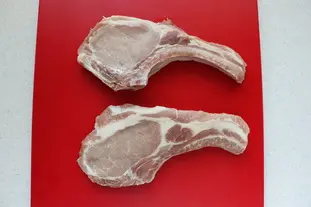This site uses only a few technical cookies necessary for its operation. By continuing to browse, you accept their use.
To find out more...
To find out more...
Incise some meats before cooking

Have you ever had this rather unpleasant phenomenon: you grill a meat, a pork chop or a veal cutlet for example, and during cooking it becomes completely deformed?
It takes a very strange shape, a bit difficult to describe, a sort of cone around the central area of the meat, which also hinders the cooking process.
It takes a very strange shape, a bit difficult to describe, a sort of cone around the central area of the meat, which also hinders the cooking process.
12 K 4.9/5 (15 reviews)
Last modified on: June 19th 2021
Incise some meats before cooking
What happened?
This painful phenomenon is related to the structure of the piece of meat, if you look at the picture of these 2 chops, the blue arrows are framing the most fleshy part (the "nut" in French).
And the nut is surrounded by a fairly thin, white ring, which is a much fattier part of the meat.
During cooking, especially if it is quick, this fatty part will shrink, without breaking or cutting, and thus contract the nut, hindering its cooking, not great...
What to do to avoid this?
This is fortunately quite simple, just cut the fatty part, incise it in at least 1 place.
A good sharp knife cut the ring (in this picture in 2 different places), and this way you are sure that, when cooking, your piece of meat will remain flat.
Note that this applies mainly to meats like chops, cutlets, or even steak, but more generally to any piece of meat that is a bit flat and you're worried about it shrinking.
To summarize: To avoid deformation when cooking a piece of meat, slit it around the nut.
Lasts posts
Butter vs. grease
We often read in a recipe where a pastry is put into a mould that, just before pouring, the mould should be buttered or greased. But what's the difference between these 2 terms?December 1st 20257825
Getting out of the fridge early
Very often when you're cooking, you need to take food or preparations out of the fridge, to use them in the recipe in progress. There's nothing tricky about this: you just take them out of the fridge and use them, usually immediately, in the recipe. But is this really a good method?November 24th 20251,0105
Who's making the croissants?
When you look at a bakery from the outside, you naturally think that in the bakery, the bakers make the bread, and in the laboratory, the pastry chefs make the cakes. It's very often like that, with each of these professions having quite different ways of working, but sometimes there's also one...November 23th 2025906
Oven height
When we put a dish or cake in the oven, we naturally tend to put it on the middle shelf, and that's what we usually do. But in some cases, this position and height can be a little tricky, so let's find out why.October 8th 20252,5305
The importance of sieving
In recipes that use a fine powder (flour, powdered sugar, etc.), you'll often see the advice to sift before using it. To sift is to pass the powder in question through a sieve (a very fine strainer) before incorporating it into your recipe. It's often advice, but is it really useful?September 3rd 20257,3923
Other pages you may also like
Tranché, dissociated, failed, in short... missed!
When preparing a sauce or a cream, there's always a (small) risk that the creamy preparation you're working on will suddenly separate into two parts of different textures: a liquid part, for example, and a more or less solid part, or even become lumpy. It's terribly frustrating, but we'll see...June 19th 202313 K5
The 3 kinds of meringue
Meringue – what could be simpler? Just beaten egg whites with sugar added. This makes a fairly stiff mixture which can then be cooked in a cool oven to create those lovely, light confections. But in the world of professional patisserie, meringue comes in three different kinds. Even if the...June 14th 201364 K4.5
Is it really necessary to cream egg yolks?
Let’s try and answer a question that crops up in cookery and patisserie, even if it verges on the existential: do the egg yolks in a custard recipe really need to be beaten until pale, or not?February 28th 201844 K4.3
Drawing a pattern in pastry
Often in the kitchen, in pastry-making, or in baking, we need to trace a pattern on a pastry. It's just a question of aesthetics but it has its effect after baking on a galette, pithiviers, pâté en croute (terrine in a pie crust), etc.May 23th 201935 K4.1
Maillard reactions
This subject cropped up recently in a discussion with my three charming nieces; do you know what Maillard reactions are? With a name like that, they could well be some principle in mechanics, but in fact the term applies to something much closer to all of us: it's what gives food more flavour...January 28th 201538 K4
Post a comment or question
Follow this page
If you are interested in this page, you can "follow" it, by entering your email address here. You will then receive a notification immediately each time the page is modified or a new comment is added. Please note that you will need to confirm this following.
Note: We'll never share your e-mail address with anyone else.
Alternatively: you can subscribe to the mailing list of cooling-ez.com , you will receive a e-mail for each new recipe published on the site.









